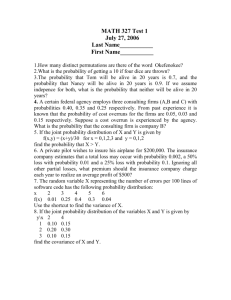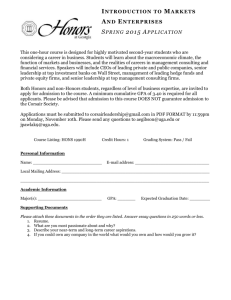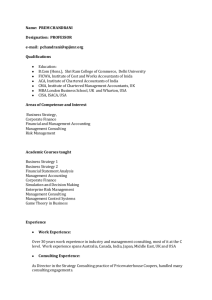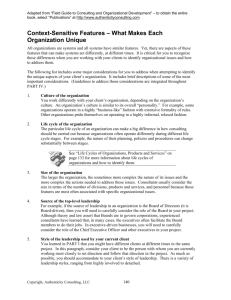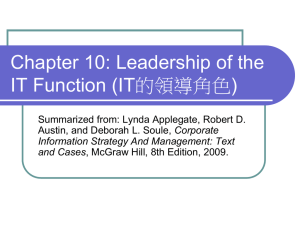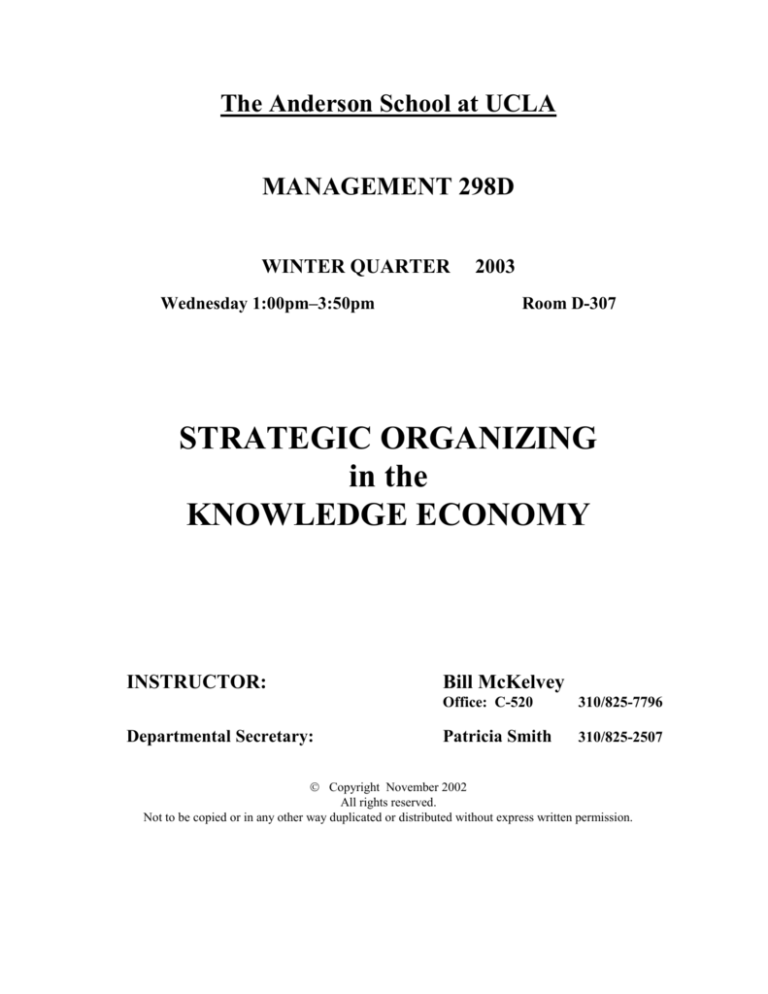
The Anderson School at UCLA
MANAGEMENT 298D
WINTER QUARTER
Wednesday 1:00pm–3:50pm
2003
Room D-307
STRATEGIC ORGANIZING
in the
KNOWLEDGE ECONOMY
INSTRUCTOR:
Departmental Secretary:
Bill McKelvey
Office: C-520
310/825-7796
Patricia Smith
310/825-2507
Copyright November 2002
All rights reserved.
Not to be copied or in any other way duplicated or distributed without express written permission.
2
COURSE DESCRIPTION
This course is designed primarily for the “post-internship student” who presumably already
has a job and, so, doesn’t have to worry about “entry level” skills. But, other students (who
have enough prior experience to be “post-entry level”) are welcome as well. It posits that MBA
graduates in consulting firms will almost immediately become Team Leaders soon after employment.
It further posits that Team Leaders will very quickly be in positions of directly advising CEOs and
other officers about (1) what to do with their firm’s organization so as to improve the organization “as
an instrument” designed for the purpose of carrying out the firm’s competitive strategy; and (2) the
scale, scope, and general course of action your consulting firm recommends.
The design of the course is intended to help you (1) get beyond narrowly codified conventional
wisdom toward an ability to apply more general and more abstract underlying principles; (2) develop
basic principles (“percentage plays”) of organizational design and improvement; (3) develop
diagnostic ability; (4) get to the heart of what a firm’s difficulties are; (5) develop strategy
implementation capabilities; (6) develop consulting, strategic organizing, and change or
transformation—and presentation—approaches most likely to appeal to a CEO and fix the apparent
problems; and finally (7) develop a “signature skill” that offers you some kind of idiosyncratic
competitive advantage as a junior consultant. In particular, the course attends to the influence of
external events on organizational functions and processes and focuses on design approaches useful
for adapting a firm to these events. Throughout, the course ties concrete organizational situations (as
reflected in cases) to basic organization design and change principles (percentage plays) most likely
to prove useful in consulting at the CEO level.
Case settings are used give students experience in confronting domestic and international strategic
organizing problems calling for diverse diagnostic and solution skills, not to mention the triggering of
a considerable number of experience gaps, tacit assumptions, beliefs and prejudices. They also
provide “windows” into the real world for purposes of applying textbook knowledge.
In consulting, “Developing the Correct Solution” usually is the lesser part of the problem,
perhaps not even a third of the problem. The other more important parts are: “Asking the Right
Questions” and “Developing the Best Implementation Approach.” Most “solutions” by hired guns
end up unused—for a variety of reasons. This course is designed to improve your competence to carry
out the three primary consulting activities. It also aims to correct the various deficiencies (if they still
exist among you) that I have observed over the past seven Deloitte Case Challenge events.
3
COURSE FORMAT
Class Presentation Assignments
For each class, selected students will present short talks on “Percentage Plays for Executives”
(from the readings), and “Proposed Solution of the Case Situation.” They may be up to ten minutes
long, using computer projected slides. They should be in the manner of consulting firm presentations
—artful, interesting, compelling, packed with substance, aimed at executives in the case (or higher
management if relevant). Assume your “contract” is ongoing but could be terminated if you make a
poor showing.
The Percentage Play talk should focus on readings-based strategic management and organization
design/change interventions that have a high probability of success on average, though not necessarily
guaranteed to work in every particular instance—like bringing in the “heat” to face the long-ball hitter
in the bottom of the ninth.
The Case Solution talk should attend to (1) your near term response to the “presenting problem,”
that is, your initial consulting approach; (2) your proposed longer term diagnostic and
consulting/organization change agenda—which could include plans for collecting additional
information; and (3) there should be a slide legitimizing the team’s approach using justification logic
stemming from the most relevant social science perspectives and principles (the percentage plays).
Individual Responsibilities
Each student is responsible for handing (via email—and don’t use an attachment): (1) Three
bullets identifying percentage plays from each chapter in the Morgan or Stacey books (when we are in
that stage of the course); or (2a) Three bullets on the percentage plays from the reading(s) for the day;
and (2b) Three bullets about the first things you would do to fix the case situation. Around 200 words
in total is about right. The deadline for the hand-ins is 8:00am Wednesday morning.
Each student should be prepared to discuss the basic principles, percentage plays, and case
materials for each class. Each student should be prepared, when called upon, to critique and/or further
elaborate the presenting student’s approach.
The final exam will be open—book, notes, readings, computers, cases—and will consist of no
more than three case analyses and possibly only one. Emphasis in the exam will be on the use of
social science perspectives and basic percentage plays to guide the consulting approach taken. The
cases used in the final exam will be drawn from the cases covered in class, except that I reserve the
right to use one new case. Using computers to write answers is required. Each answer no more than
one page. You can email them to me, but be sure time/date is before end of exam period.
Grading of class participation will be based on a subjective evaluation of the quality of your
individual contribution to the discussion about a case, reading, or issue. This will depend on a your
preparation and understanding of the cases and readings. This instructor prefers the “Chicago style”
of aggressive “courtroom adversarial” pursuit of truth and searching for the best consulting
approach—among students and between students and instructor—but recognizes that to some people
this style is about as attractive as the weather in Chicago! So let’s aim for an intense search for truth
4
and excellence in a climate of respect and friendship—and perhaps even fun! Unlike many CEOs, I
will not walk out in the face of a poor presentation! The job is not only to present but also to learn
how to field questions ranging from the relevant to the obnoxious. All students are expected to help
out in this. The class will also be a clinic on how to become better and designing presentations and
presenting them.
It is very difficult for you to demonstrate your preparation, share your insights with others, or learn
from the class discussion and instructors comments if you are absent. The norm is that one absence
may be unavoidable; more than that indicates poor planning. I will count absent any student who is
not in his or her seat for the entire length of a class session. Excuses are possible, but they should be
of the kind, "My mother was hit by a comet yesterday and there was no ice."
Final Grade Assignment
Let’s try to be a “zero-defect” total-quality-management class. I would hope everyone works hard
enough to get some kind of an “A.” After all, if you aren’t an “A” quality student, you wouldn’t have
a job with a consulting firm, and you shouldn’t be in this class. Of course, if you really screw up……
Opportunities to convince me you don’t deserve an “A” of some kind will depend on
presentations, classroom discussion, and the final exam. Weighting is around 25%, 25%, 50%.
REQUIRED READING MATERIAL
Textbooks:
Gareth R. Jones, Organizational Theory (3rd ed.), Addison-Wesley, 2000. (Amazon, used,
from $54; if you want to buy the earlier, cheaper 2nd edition, that would be ok.)
Gareth Morgan, Images of Organization (2nd ed.), Sage, 1998. (Amazon, used, from $15.)
Robert Slater, Get Better or Get Beaten: 29 Leadership Secrets from GE’s Jack Welch 2nd ed.,
New York, McGraw-Hill, 2001. (Amazon, used, from $7.51.)
Ralph D. Stacey, Complex Responsive Processes in Organizations, London: Routledge, 2001.
(Amazon, used, from $27.24.)
Cases and Readings Packet
5
SCHEDULE OF CLASS SESSIONS
1. (1/8a) Introduction
Content Perspective
Strategy: Evaluating, Finding, Implementing
A Short History of Strategic Thinking
Porter: “What is Strategy?” (HBR, Nov.-Dec., 1996)
Please read this article before the 1st class!
Packet
Basic Management
The Morgan Book
The Stacey Book
The Jones Text
Integrating
—The A Plot
—The B Plot
—The C Plot
—The D Plot
Managing Distributed Intelligence
Henry Ford’s Quote
A Nonlinear World
Human and Social Capital
Distributed Intelligence and Distributed Leadership
Complexity Theory
How to Manage Distributed Intelligence?
Creating the “Soil” for Long-Term Organizational Success
Companies “Built to Last”
Recent “Most Successful” Firms
GE
Course Design Issues:
1. Purpose,
3. Responsibilities, etc.
5. Class Format
7. Forming Teams
2. Scope,
4. Presentations
6. Exam
PERCENTAGE PLAYS FROM VARIOUS SOCIAL SCIENCE PERSPECTIVES
2. (1/8b) Basic Principles of Organizing:
Social Dynamics:
Sociology:
Firms as Machines
Anthropology:
Firms as Cultures
Morgan-Ch. 2
Morgan-Ch. 5
3. (1/15a) Basic Principles of Organizing:
Competitive Dynamics:
Economics:
Firms as Rational/Opportunistic
Political Science:
Firms as Political Systems
Besanko, Ch. 3
Morgan-Ch. 6
4. (1/15b) Basic Principles of Organizing:
Individual Dynamics:
Psychology:
Firms as Psychic Prisons
Firms as Brains
Morgan-Ch. 7
Morgan-Ch. 4
5. (1/22a) Basic Principles of Organizing:
Adaptive Dynamics:
Biology:
Firms as Organisms
Systems Theory:
Firms as Adaptive Systems
Morgan-Ch.3
Morgan-Ch. 8
6
MANAGING DISTRIBUTED INTELLIGENCE AND ORDER CREATION
6. (1/22b) Foundations of Learning and Knowledge Creation in Organizations:
READ:
Stacey, Chs. 1–3.
CASE:
Ellen Moore (Korea) (1998)
[97G029]
7. (1/29a) Distributed Intelligence and Complexity:
READ:
Stacey, Chs. 4–5
McKelvey, “Microstrategy—MacroLeadership…”.
CASE:
Skandia AFS (Sweden) (1997)
[9-396-412]
8. (1/29b) Self-Organization:
READ:
Stacey, Chs. 6–7
McKelvey, “Managing Coevolutionary Dynamics…”
CASE:
Hewlett-Packard Barcelona Division (1996)
[IES025]
(2/5)
NO CLASS
9. (2/12a) Complex Response Processes and Systems Thinking:
READ:
Stacey, Chs. 8–10
McKelvey, “Toward a Complexity theory of Entrepreneurship”
CASE:
Jack Welch’s Second Wave A (1990)
[9-391-248]
B (1992)
[9-392-113]
10. (2/12b) The GE Story:
READ:
The GM’s Leadership Challenge….
Slater’s book
John Trani’s First Year (1998)
[9-397-023]
[9-398-076]
7
FIXING CGO GOVERNANCE PROBLEMS
11. (2/14a) The Strategy-Structure Problem—The Organization as an Instrument:
READ:
Jones-Ch. 7.
CASE:
People Express (1985+)
[9-490-012]
Southwest Airlines (1994)
[HR1A]
12. (2/14b) The Vertical Integration Problem—Bureaucracy:
READ:
Jones-Ch. 2
CASE:
GM (1994)
[Jones #15]
13. (2/19a) The Multidivisional Problem—M & H Forms:
READ:
Jones-Ch. 3
CASE:
Texana Petroleum (1966)
VIACOM by Spencer Wolf (2002)
[Jones # 6]
[handout]
14. (2/19b) The Boundary Problem—Networks & Alliances:
READ:
Jones-Ch. 6
CASE:
Komatsu and Dresser (US/Japan) (1998)
[9-898-269]
15. (2/26a) The Multinational Problem:
READ:
Jones-Ch. 8
Bartlett & Ghoshal, “Organizing for World Wide Effectiveness....”
[CMR019, p. 83]
CASE:
Corning Glass Works A , B1, B2, C1, C2 [9-381-160 to 164]
8
FIXING SBU GOVERNANCE PROBLEMS
16. (2/26b) The Workplace Problem—Socio-Technical Systems Design (Make-up):
READ:
Jones-Chs. 9, 10
CASE:
Cypress Semiconductors (A) (1998)
[HR8A]
17. (3/5a) The Culture Problem—A Two Edged Sword:
READ:
Jones- Ch. 5
CASE:
Jan Eriksson-Novartis Indonesia (A) (1998)
[9-898-219]
18. (3/5b) The Influence Problem—Power Equalization & Self-Managing Teams:
READ:
Jones-Ch. 14
CASE:
Anderson Consulting-EMEAI (Europe) (1996)
[9-396-007]
19. (3/12a) The Agency Problem—Incentive Approaches:
READ:
Besanko, et al. Ch. 16.
CASE:
Lyondell Petrochemical Co. (1998)
[9-489-028]
20. (3/12b) The Off-Shore Management Problem—Running the Foreign Division:
READ:
Rosenzweig, “National Culture and Management” [9-394-177]
CASE:
Lincoln Electric (SE Asia) (1998)
[9-398-095]

